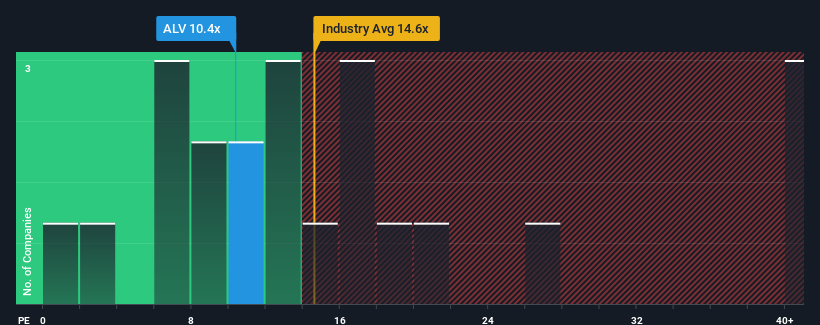Autoliv, Inc. (NYSE:ALV) Screens Well But There Might Be A Catch
When close to half the companies in the United States have price-to-earnings ratios (or "P/E's") above 17x, you may consider Autoliv, Inc. (NYSE:ALV) as an attractive investment with its 10.4x P/E ratio. However, the P/E might be low for a reason and it requires further investigation to determine if it's justified.
We've discovered 2 warning signs about Autoliv. View them for free.With earnings growth that's superior to most other companies of late, Autoliv has been doing relatively well. One possibility is that the P/E is low because investors think this strong earnings performance might be less impressive moving forward. If not, then existing shareholders have reason to be quite optimistic about the future direction of the share price.
Check out our latest analysis for Autoliv

Is There Any Growth For Autoliv?
The only time you'd be truly comfortable seeing a P/E as low as Autoliv's is when the company's growth is on track to lag the market.
If we review the last year of earnings growth, the company posted a terrific increase of 35%. Pleasingly, EPS has also lifted 115% in aggregate from three years ago, thanks to the last 12 months of growth. Therefore, it's fair to say the earnings growth recently has been superb for the company.
Turning to the outlook, the next three years should generate growth of 10% per year as estimated by the analysts watching the company. That's shaping up to be similar to the 10% per year growth forecast for the broader market.
With this information, we find it odd that Autoliv is trading at a P/E lower than the market. It may be that most investors are not convinced the company can achieve future growth expectations.
The Final Word
Typically, we'd caution against reading too much into price-to-earnings ratios when settling on investment decisions, though it can reveal plenty about what other market participants think about the company.
We've established that Autoliv currently trades on a lower than expected P/E since its forecast growth is in line with the wider market. When we see an average earnings outlook with market-like growth, we assume potential risks are what might be placing pressure on the P/E ratio. It appears some are indeed anticipating earnings instability, because these conditions should normally provide more support to the share price.
It's always necessary to consider the ever-present spectre of investment risk. We've identified 2 warning signs with Autoliv, and understanding these should be part of your investment process.
It's important to make sure you look for a great company, not just the first idea you come across. So take a peek at this free list of interesting companies with strong recent earnings growth (and a low P/E).
Have feedback on this article? Concerned about the content? Get in touch with us directly. Alternatively, email editorial-team (at) simplywallst.com.
This article by Simply Wall St is general in nature. We provide commentary based on historical data and analyst forecasts only using an unbiased methodology and our articles are not intended to be financial advice. It does not constitute a recommendation to buy or sell any stock, and does not take account of your objectives, or your financial situation. We aim to bring you long-term focused analysis driven by fundamental data. Note that our analysis may not factor in the latest price-sensitive company announcements or qualitative material. Simply Wall St has no position in any stocks mentioned.
 Wall Street Journal
Wall Street Journal